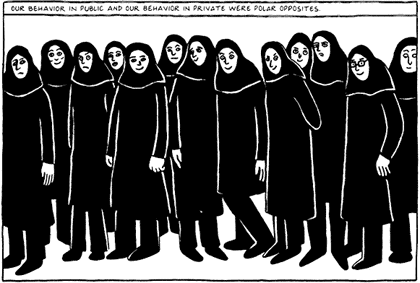

In the wake of Iran’s Islamic Revolution, Marjane Satrapi’s middle-class parents sent her to boarding school in Vienna. Satrapi returned to Iran in the mid-1980s, as the country continued to fight a bloody war with Iraq. By 1989 she had enrolled in the art program at Iran’s state university. Sixbillion.org publishes excerpts from Satrapi’s book Persepolis 2, the sequel to Persepolis, Marjane Satrapi’s memoir about growing up in Iran. I found this “cartoon” very touching.
Sixbillion.org also published an interactive exposé on what happens to a shaheed’s (martyr, dead terrorist, whatever…) body once it is returned for burial.
I got to those two links after reading an intimate series of articles by a Sixbillion.org editor in Slate. Kelly McEvers wrote about the time she spent with Paridah binti Abas, the wife of Ali Gufron bin Nurhasyim, aka Mukhlas, a leader in Indonesia’s Jemaah Islamiyah, and the ringleader of the brutal 2002 suicide bombings in Bali.
These articles are all very different, but what unites them all is not so much the fact that they deal in one form or another with Islamic fundamentalism. The thing that struck me while reading these was an overwhelming sense of banality. Go figure. Maybe Hannah Arendt would have had something to say about that.
- Jews Blessed by their High Priests - 10/14/2022
- Foolproof Mufletta Recipe & Muflettapalooza / Mimouna Invite! - 3/26/2021
- Jewish Poles who will Amaze You - 1/29/2021






I’d never imagined what happened to the body of a “martyr” after he is killed. Wouldn’t it be so much more ecologically sound, though, if they just left the bodies for the vultures? At last the martyrs would be contributing something to the world.
Not just banality ck – the wide-eyed gullibility of the Westerners, their eagerness to experience someone else’s “gritty reality” – and how their wish to romanticize it nullifies any moral judgement.